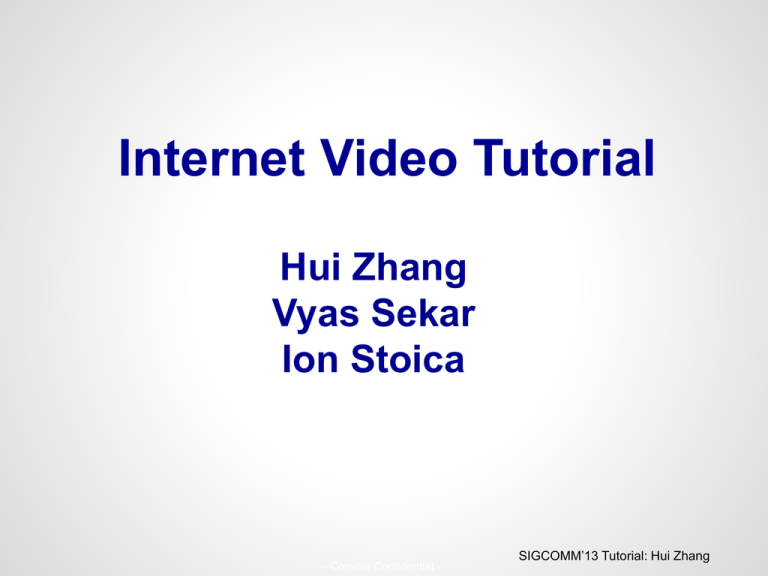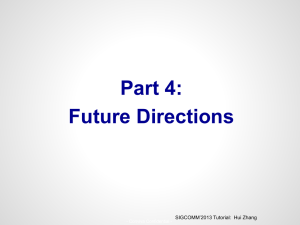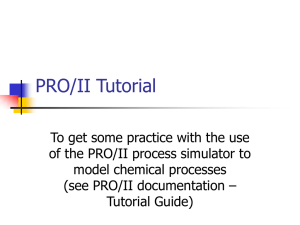Tutorial - Sigcomm
advertisement

Internet Video Tutorial Hui Zhang Vyas Sekar Ion Stoica - Conviva Confidential - SIGCOMM’13 Tutorial: Hui Zhang Tutorial Overview Past, present, and future of Internet video from both industry and research perspective Industry vs research evolution/disconnect/synergy Industry: Evolution of Internet video ecosystem in last 20 years Evolution of key technologies in last 20 years Drivers for future evolution Research: Research focus prior to growth of Internet video industry Latest research works responding to and enabled by changing industry landscape and application scenario’s New research directions to address future challenges SIGCOMM’13 Tutorial: Hui Zhang Tutorial Outline Part 1: evolution of Internet video ecosystem Part 2: latest research on relationship between user engagement and video quality Enabling new data source: detailed & comprehensive client-side measurement Data analysis techniques useful in this context Part 3: latest research on improving video quality New problem formulations in the context of today’s Internet video ecosystem Part 4: future directions Drivers for future changes in Internet video ecosystem Drivers and opportunities for future research SIGCOMM’13 Tutorial: Hui Zhang Part 1: Evolution of Internet Video Ecosystem - Conviva Confidential - SIGCOMM’13 Tutorial: Hui Zhang Part 1 Outline Three periods of Internet video evolution Evolution of video delivery protocols Today’s end-to-end video eco-system SIGCOMM’13 Tutorial: Hui Zhang Part 1 Outline Three periods of Internet video evolution – 2004 2005 – 2010 2010 1992 Evolution of video delivery protocols Today’s end-to-end video eco-system SIGCOMM’13 Tutorial: Hui Zhang Research Efforts in 1990s Quality of Service support inside network Packet scheduling algorithms Reservation Intserv, protocols Diffserv IP Multicast Layered coding Adaptive applications Programming model for multi-media applications SIGCOMM’13 Tutorial: Hui Zhang … and Multi-party Conferencing Was The Motivating Application … SIGCOMM’13 Tutorial: Hui Zhang8 Video Research in Early 2000s Peer to Peer End Bit System Multicast torrent Coolstreaming, PPLive SIGCOMM’13 Tutorial: Hui Zhang 1990 – 2004: 1st Generation Commercial PC/Packet Video Technologies Simple video playback, no support for rich app Not well integrated with Web browser Proprietary protocols, servers, and streamers No critical mass of compelling content over Internet Not enough broadband penetration SIGCOMM’13 Tutorial: Hui Zhang10 Internet Growth 1994 – 2004: Web Internet … Not the Video Internet SIGCOMM’13 Tutorial: Hui Zhang11 2005: Beginning of Internet/Web Video Era 100M streams first year Premium Sports Webcast on Line SIGCOMM’13 Tutorial: Hui Zhang 2006 – 2011: Internet Video Going Prime Time 2006 2007 2008 2009 2010 2011 SIGCOMM’13 Tutorial: Hui Zhang Flash: Enabling Technology For Phase 2 Growth 2005-2011 Client-side: Flash being the de-facto platform Works in all browsers Works across OSes RTMP being the protocol Maturing CDN technologies to support streaming SIGCOMM’13 Tutorial: Hui Zhang What is Flash? Browser plugin developed by Macromedia (acquired by Adobe in 2005) A programming environment that is independent of browser types and OSes Rich interactive features and seamless browser integration desktop application-like features Flash Player 9.0 + ActionScript 3.0 introduced in 2006 brought a new virtual machine and a just-in-time compiler with 10x performance improvements enabling a wave of more sophisticated and interactive video and web applications Support for video Rendering, decoding, introduced H.264 in 2007 Streaming (RTMP), Content protection (RTMPE, tokenization) More than 95% penetration on PCs SIGCOMM’13 Tutorial: Hui Zhang 2010: Apps and Multi-Devices Rise of apps and the the slow decline of Flash as the universal video platform iPhone was launched on June 29th, 2007 without support for Flash iPad was launched on April 3rd, 2010 also without support for Flash Adobe announced removing support for Flash on Android on June 27th, 2012 (almost exactly 5 years after iPhone launched) SIGCOMM’13 Tutorial: Hui Zhang 2011 – Present Four separate screens PC Phone Tablet TV: connected directly to Internet or via other devices (e.g. Roku, Xbox, PlayStation, AppleTV) Different user behaviors and video applications for different screens Fragmented playback software environment Apps on mobile and tablet devices (iOS, Android) Apps on game consoles and connected TVs (Xbox, PS3, Roku, AppleTV, Samsung TV, LG TV, etc.) Both Flash and Silverlight on PCs SIGCOMM’13 Tutorial: Hui Zhang Part 1 Outline Three periods of Internet video evolution Evolution of video delivery protocols Today’s end-to-end video eco-system SIGCOMM’13 Tutorial: Hui Zhang Internet Video Requirements Smooth/continuous playback Elasticity to startup delay: need to think in terms of RTTs Elasticity to throughput Multiple encodings: 200Kbps, 1Mbps, 2 Mbps, 6 Mbps, 30Mbps Multiple classes of applications with different requirements Delay 2, N-way conference Bandwidth < 200 ms 4 kbps audio only, 200 kbps – 5 Mbps video Examples Skype, Google hangout, Polycom, Cisco Short form VoD < 1-5s 300 kbps – 2 Mbps & higher Youtube Long form VoD < 5-30s 500 kbps – 6 Mbps & higher Netflix, Hulu, Qiyi, HBOGO Live Broadcast < 5-10s 500 kbps – 6 Mbps & higher WatchESPN, MLB Linear Channel < 60s 500 kbps – 6 Mbps & higher DirectTV Live SIGCOMM’13 Tutorial: Hui Zhang Max Buffer Duration "Bad": Buffer overrflows Max Buffer Size File Position Playout Buffer, Delay, Smooth Playback Buffer Duration "Good" Region: smooth playback Buffer Size = allowable jitter "Bad": Buffer underflows and playback stops Buffer almost empty Time SIGCOMM’13 Tutorial: Hui Zhang First Generation: HTTP Download A simple architecture is to have the Browser request the object(s) and after their reception pass them to the player for display No pipelining SIGCOMM’13 Tutorial: Hui Zhang First Gen: HTTP Progressive Download (2) Alternative: set up connection between server and player; player takes over Web browser requests and receives a Meta File (a file describing the object) instead of receiving the file itself; Browser launches the appropriate Player and passes it the Meta File; Player sets up a TCP connection with Web Server and downloads or streams the file SIGCOMM’13 Tutorial: Hui Zhang Drawbacks of HTTP Progressive Download HTTP connection keeps data flowing as fast as possible to user's local buffer May download lots of extra data if you do not watch the video TCP file transfer can use more bandwidth than necessary Mismatch between whole file transfer and stop/start/seek playback controls. However: use file range requests to seek to video position Cannot change video quality (bit rate) to adapt to network congestion SIGCOMM’13 Tutorial: Hui Zhang 2nd Generation: Stateful Sessionbased Proprietary Streaming Protocols Separate control & data connections for the session Control connection: start, rewind, fast forward, pause Data connection: either TCP or UDP (not HTTP) Stateful server keeps session state Examples: RTSP, RTMP SIGCOMM’13 Tutorial: Hui Zhang RTSP Operation SIGCOMM’13 Tutorial: Hui Zhang Issues with RTSP, RTMP Web servers ride on higher performance/price curve than specialized streaming servers Security concerns resulting in blocking of UDP or TCP with non-standard port numbers SIGCOMM’13 Tutorial: Hui Zhang 3rd Generation: HTTP Streaming Key observations: rather than adapt Internet to streaming, adapt media delivery to the Internet Other terms for similar concepts: Adaptive Streaming, Smooth Streaming, HTTP Chunking Client-centric architecture with stateful client and stateless server Standard server: Web servers Standard Protocol: HTTP Session state and logic maintained at client Video is broken into multiple chunks Chunks begin with keyframe so independent of other chunks A series of HTTP progressive downloads of chunks Playing chunks in sequence gives seamless video SIGCOMM’13 Tutorial: Hui Zhang Adaptive Multi-Bit Rate with HTTP Streaming Encode video at different levels of quality/bandwidth Client can adapt to different bit rates within a single session by requesting different sized chunks Chunks of different bit rates must be synchronized All encodings have the same chunk boundaries and all chunks start with key frames, so you can make smooth splices to chunks of higher or lower bit rates SIGCOMM’13 Tutorial: Hui Zhang HTTP Chunking Protocol Server Client HTTP Adaptive Player Web browser A1 HTTP HTTPGET GETB2A1 Cache B1 A A11 A2 … B1 BB22 A1 A2 … B1 B2 … Web server HTTP HTTP TCP TCP … Web server SIGCOMM’13 Tutorial: Hui Zhang Reasons for Wide Adoption Client-driven control enables server/CDN switch CDN Infrastructure Client HTTP Adaptive Player Web browser A1 Cache B1 A1 A2 … B1 B2 A2 … B1 B2 … Web server HTTP HTTP TCP TCP Middlebox/firewall penetration A1 … Web server Reuse the CDN infrastructure SIGCOMM’13 Tutorial: Hui Zhang Example of HTTP Streaming Protocols Apple HLS: HTTP Live Streaming Microsoft IIS Smooth Streaming: part of Silverlight Adobe HDS: HTTP Dynamic Streaming DASH: Dynamic Adaptive Streaming over HTTP SIGCOMM’13 Tutorial: Hui Zhang Smooth Streaming .ISMC 5Mbps.MP4 CharlieBitMe_10 Mbps.MP4 Mezzanine file .ISM Server & Client Manifest files Encoders 1Mbps .MP4 50 0 IIS Server with Smooth Streaming Extension Fetch Client Manifest File HTTP GET http://video.foo.com/CharlieBiteMe.ism/ QualityLevels(500000)/Fragments(video=0 ) HTTP GET http://video.foo.com/CharlieBiteMe.ism/Qu SIGCOMM’13 Tutorial: Hui Zhang alityLevels(1000000)/Fragments(video=30000 Per-bitrate.ts Stream media segment Segmenters files & playlists HTTP Live Streaming (HLS) 5Mbps.MP4 CharlieBitMe_10 Mbps.MP4 Mezzanine file Encoders .m3u8 1Mbps .MP4 .m3u8 50 0 .m3u8 .m3u8 Master Playlist Fetch master play list Web Server Fetch bitrate specific playlist HTTP GET http://media.example.com/segment0.ts SIGCOMM’13 Tutorial: Hui Zhang HTTP Dynamic Streaming (HDS) f4f Packager Per-bitrate.f4f segment & .f4m manifest files 5Mbps.MP4 CharlieBitMe_10 Mbps.MP4 Mezzanine file Encoders .f4m 1Mbps .MP4 .f4m 50 0 .f4m Apache with Adobe HTTP Origin module HTTP GET http://www.example.com/ media/CharlieBitMe.f4m HTTP GET http://www.example.com/media/http_dy namic_StreamingSeg1-Frag1 SIGCOMM’13 Tutorial: Hui Zhang Part 1 Outline Three periods of Internet video evolution Evolution of video delivery protocols Today’s end-to-end video eco-system SIGCOMM’13 Tutorial: Hui Zhang Internet Video Data-plane Video Source Screen Video Player Encoders & Video Servers CMS and Hostin g Content Delivery Networks (CDN) ISP & Home Net SIGCOMM’13 Tutorial: Hui Zhang E2E Workflow: Publisher Perspective Mezzanine file creation •High resulution file creation using commercial video editing tools Content and metadata management •Metadata associated with content •Content published into a CMS Content preparation •Prepare content with required renditions and formats •Upload to origin(s) Origin storage •Store content for use by CDNs •Use either one multi-CDN origin or multiple CDN collocated origins Delivery (CDN and Protocol) •Deliver content to the audience •Scale to the audience size as needed Video Player •Access, stream, and display content to the audience SIGCOMM’13 Tutorial: Hui Zhang E2E Workflow: Publisher Perspective VoD Mezzanine file Content Managemen t System Progressive Download RTMPE HLS Encoders Packagers CDN Smooth Streaming HLS Live Stream SIGCOMM’13 Tutorial: Hui Zhang More Complexity with Security VoD Mezzanine file Content Managemen t System Progressive Download RTMPE HLS Encoders Packagers + Encryption CDN Smooth Streaming HLS Live Stream License Servers SIGCOMM’13 Tutorial: Hui Zhang + Decryption A Simplified Model of Video Advertisement Workflow Targeting & Validation Partners Ad Content Ad Proxies 3rd Party CDN’s Campaign Management Systems 3rd Party Ad Networks Content Delivery Networks (CDN) SIGCOMM’13 Tutorial: Hui Zhang State of Internet Video and Implications for Researchers SIGCOMM’13 Tutorial: Hui Zhang Video Traffic Is Dominating Internet Traffic 66% Internet Traffic is Video Video Non-video SIGCOMM’13 Tutorial: Hui Zhang The Video Internet: A World Full of Elephants What Does It Mean For the Internet If 95% Traffic is Video? Video (100x traffic growth) Other Applications (10 x traffic growth) 2011 2016 SIGCOMM’13 Tutorial: Hui Zhang What We Have Learned So Far? (1) Video & Web Internet 1990 Internet Web Internet The detour to Web Internet has a key positive legacy HTTP chunk will be the new Datagram for Internet video HTTP chunk switches are the new switches/CDN servers Many practical problems solved for HTTP after years of evolution Middle-box support, authentication, firewall penetration, anycast SIGCOMM’13 Tutorial: Hui Zhang44 What Have We Learned So Far (2) ? No universal QoS support inside the network CDN a key architectural component to optimize performance DNS-based names are standard control service access interface HTTP is standard data plane plane protocol SIGCOMM’13 Tutorial: Hui Zhang What We Have Learned So Far (3)? Adaptive multi-bit-rate video key to address diversity CDN ISP GEO Device SIGCOMM’13 Tutorial: Hui Zhang What Have We Learned (4)? Consumer devices, software architecture, and video applications critical in shaping delivery architecture Latency with seconds or 10s of seconds allow sophisticated algorithms to be implemented at multiple locations in the end-to-end delivery pipeline Client machines CDN edge nodes Proxy servers inside ISP networks Security servers Ad servers Other data plane or control plane proxy servers SIGCOMM’13 Tutorial: Hui Zhang Rest of Tutorial Focus on latest research on Internet video quality Importance driven by multiple trends lean forward experience lean back experience short form long form free content paid and premium content low resolution high resolution Part 2: new understanding of video quality metric enabled by new data source: detailed & comprehensive client-side measurement Data analysis techniques useful in this context Part 3: latest research on improving video quality new problem formulations in the context of today’s Internet video ecosystem SIGCOMM’13 Tutorial: Hui Zhang






